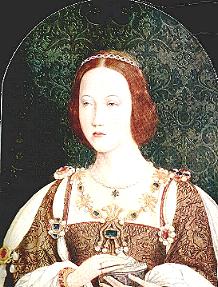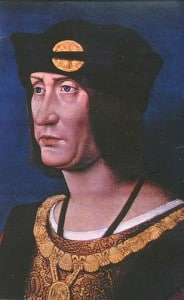
On this day in history, 9th October 1514, the 18 year old Mary Tudor, sister of Henry VIII, married the 52 year old King Louis XII of France at Abbeville.
In a letter to Antonio Triulzi, Bishop of Asti, dated the 10th October 1514, the Venetian ambassador described Mary Tudor’s arrival in Abbeville and the wedding:-
“Then followed the Queen, under a white canopy, above and around which were the roses, supported by two porcupines. She was alone beneath it, and Monseigneur [d’Angoulême] on her left hand, but outside. She rode a white palfrey, with rich trappings, and was herself clad in very handsome stiff brocade.
Next came her litter, very beautiful, adorned with lilies; then five of the principal English ladies, very well dressed; then a carriage of brocade, on which were four ladies, followed by a second carriage with as many more ladies. Next came six ladies on horseback; and then a third carriage, of purple and crimson velvet (veluto paonazo cremesin), with four ladies; after which a crowd of ladies, some twenty in number; then 150 archers in three liveries. In this order they went to the Queen’s house, which was near that of the King. It was a sumptuous entry, and these noblemen of England have very large chains, and are otherwise in good array.
Before the entry there was a heavy shower, which drenched them all, especially the ladies. The Queen was dressed in the English fashion. In the evening, “Madame,” the King’s daughter, wife of Monseigneur dAngoulême, went to visit her, and they gave a ball. This morning the King had preparation made for the mass in his own hall (salla), whither the Queen came, preceded by 73 (sic) English barons and gentlemen; the King doffed his bonnet, and the Queen curtseyed to the ground, whereupon his Majesty kissed her. The treasurer Robertet then presented to the King a necklace, in which were set two beautiful jewels, and his Majesty placed it round the Queen’s neck; after which mass was performed.
The two candles were held, the one by Monseigneur de Vendôme and the other by the Prince de Vendôme. After the King had kissed the “1 pax ” at the mass, he kissed the Queen. At the offertory Monseigneur [d’Angoulême?] gave the money to the King, and Madame to the Queen.
The mass by the Cardinal de Bayeux being ended, he gave the consecrated wafer, one half to the King and the other to the Queen, who kissed and then swallowed it; and after making a graceful curtsey she departed, the King and Queen going each to their own apartments to dine. In the evening the Queen arrayed herself in the French fashion, and there was dancing; the whole Court banqueting, dancing, and making good cheer; and thus, at the eighth hour before midnight, the Queen was taken away from the entertainment by Madame to go and sleep with the King.
I promise you that she is very handsome, and of sufficiently tall stature (de statura honestamente granda). She appears to me rather pale, though this 1 believe proceeds from the tossing of the sea and from her fright. She does not seem a whit more than 16 years old, and looks very well in the French costume. She is extremely courteous and well mannered, and has come in very sumptuous array…” 1
There is another account in the same archives (Calendar of State Papers Relating to English Affairs in the Archives of Venice, Volume 2: 1509-1519) of Mary Tudor’s entrance to Abbeville and the wedding, in which Mary is described:-
“She is generally considered handsome and well favoured, were not her eyes and eyebrows too light; for the rest it appears to me that nature optime suplevit: she is slight, rather than defective from corpulence, and conducts herself with so much grace, and has such good manners, that for her age of 18 years—and she does not look more—she is a paradise.”2
We know that Thomas Boleyn wrote to Margaret of Austria to get his daughter, Anne Boleyn, released from her service because she had been appointed to serve Mary Tudor in France, and we have two mentions of a “Mademoiselle Boleyn” in the British records of Mary Tudor’s arrival in France:
“Gentlewomen which were appointed to have abidden in France with the French Queen:—Dame _ Guylford, lady of honor, Lady Elizabeth Grey, Eliz. Ferrys. M. Ann Devereux, _ Grey of Wilton, M. Boleyne, M. Wotton, Alice Denys and Anne Ferningham (Jerningham?), chamberers, Dr. Denton, almoner, Mr. Palgrave, secretary, _ (blank), chaplains.”3

The above list is a list of ladies appointed to serve Mary Tudor and the list below is the people chosen by King Louis XII to remain in France and serve his wife. He upset his new bride by dismissing many of her entourage and sending them home to England:-
“Le conte de Nonshere,” Dr. Denton, almoner, Mr. Richard Blounte, “escuyer descuyerie,” the sons of Lord Roos, Lord Cobham, and Mr. Seymour, “enfans d’honneur”; Evrard, brother of the Marquis, Arthur Polle, brother of Lord Montague, Le Poulayn, “pannetiers échansons et valetz trenchans”; Francis Buddis, usher of the chamber, Maistre Guillaume, physician, Henry Calays, “varlet des robes,” Rob. Wast. Mesdemoiselles Grey (sister of the Marquis), Mary Finis (daughter of Lord Dacres), Elizabeth (sister of Lord Grey), Madamoyselle Boleyne, Maistres Anne Jenyngham, “femme de chambre,” and Jeanne Barnesse, “chamberiere.” Signed by Louis XII.”4
You can find out more about Mary Tudor, Queen of France, in my article “Princess Mary Tudor”.
Sources
- Calendar of State Papers Relating to English Affairs in the Archives of Venice, Volume 2: 1509-1519, 508
- Ibid., 511
- LP i.3348
- Ibid., 3357
I don’t know, but could it be that the Boleyne referred to in the records of Mary Tudor’s arrival in France relate to Mary rather than Anne? When the records just say Madamoysalle Boleyne it makes it very confusing when both of them served her.
Great account, Claire; as usual! I’ve linked it from Ci-Devant, if that’s OK xx
Thanks for the great post! U have some interesting stuff here on some of my favorite subjects…I will be following your blog from now on!
Mary like most ladies of royal or noble birth in those days was nothing more than a bargaining chip for the prestige and peace of two kingdoms. I am sure that Henry dearly loved his little sister; he always said as much, but he certainly did not put sentiment into his choice of a bridegroom. Louis at 52 was no prize, and had been married twice before. He was a widow and a divorcee, but he had been an active warrior in his day as well. Mary was treated well in France and by her new husband, she did not have anything to complain about, and lucky for her, he popped his clogs within a few months. All sounds like a marvellous and sumptuous affair, but I am sure that she was less than happy about the whole matter.
However, Mary, being a fiery Tudor had made a condition for agreeing to this marriage, that of the so called promise that she could make her own choice of marriage next time. And we all know who that was! Luckily for her, Henry sent the very man to bring her home: Charles Brandon, Duke of Suffolk.
Very interesting thank u Clair !!!